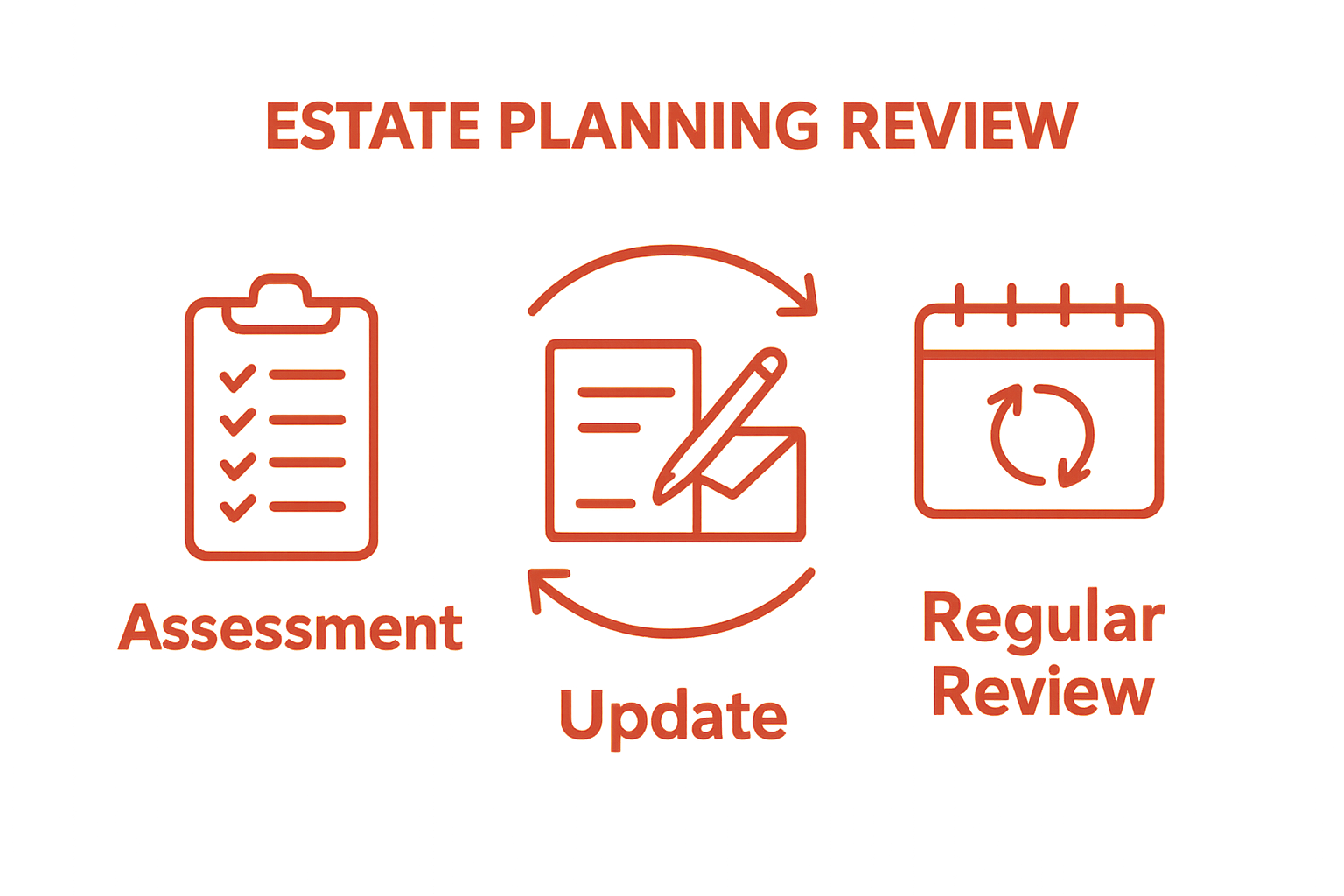
PARENTS & HOMEOWNERS: MY 7-STEP ESTATE PLANNING PROCESS WILL PROTECT YOUR HEIRS
From Creditors, Predators & Bad Choices, And Will Help You Become a (Bigger) Hero to Your Family!



How to Avoid Estate Litigation: Secure Your Legacy
Estate plans are often treated like old family photo albums. They get tucked away and forgotten until someone needs them, and by then, surprises can pop up. Almost half of all Americans have estate plans that are outdated or incomplete, leaving families exposed to unnecessary risk. The twist is that the easiest way to prevent bitter disputes and costly court battles is not a complex legal maneuver but a simple strategy any family can follow.
Table of Contents
- Step 1: Assess Your Current Estate Plan
- Step 2: Update And Customize Legal Documents
- Step 3: Communicate Your Wishes Clearly
- Step 4: Establish A Family Governance Plan
- Step 5: Review And Revise Regularly
Quick Summary
| Key Point | Explanation |
|---|---|
| 1. Assess Your Current Estate Plan | Review existing estate documents for updates every five years or after major life events. |
| 2. Update and Customize Legal Documents | Tailor documents to your family’s unique situation, including wills, trusts, and healthcare directives. |
| 3. Communicate Your Wishes Clearly | Hold family meetings to discuss your estate planning decisions and avoid future conflict. |
| 4. Establish a Family Governance Plan | Create a family charter to manage conflicts and ensure smooth wealth transition across generations. |
| 5. Review and Revise Regularly | Schedule reviews every three to five years to ensure documents reflect current wishes and legal standards. |
Step 1: Assess Your Current Estate Plan
Understanding the current state of your estate plan is the critical first step in preventing potential litigation and securing your family’s financial future. Many individuals unknowingly have outdated or incomplete estate documents that could expose their loved ones to significant legal risks and financial complications.
Begin by gathering all existing estate planning documents in one secure location. This includes your will, trust agreements, power of attorney documents, healthcare directives, beneficiary designations, and any previous estate planning correspondence. Pay special attention to documents created more than five years ago, as significant life changes might have rendered them obsolete or ineffective.
Carefully review each document with a critical eye, looking for potential gaps or outdated provisions. Major life events like marriages, divorces, births, deaths, significant financial changes, or relocation can dramatically impact the effectiveness of your existing estate plan. For instance, a will drafted before the birth of a child or a significant increase in net worth may not adequately protect your current family structure or asset portfolio.
When examining your documents, ask yourself key verification questions: Do the named guardians for minor children still make sense? Are beneficiary designations current and aligned with your wishes? Have significant asset acquisitions or business interests been properly integrated into your estate plan? Check out our guide on updating your estate plan after major life changes for more detailed insights.
If you discover inconsistencies or outdated provisions, consider these critical verification criteria for a comprehensive estate plan:
- Current and accurate beneficiary designations
- Explicit guardianship instructions for minor children
- Clear asset distribution guidelines
- Comprehensive healthcare directives
- Up-to-date power of attorney documents
Remember, an assessment is not just about identifying problems but understanding the potential legal vulnerabilities that could lead to family conflicts or costly litigation. A thorough review now can save your loved ones significant emotional and financial stress in the future.
The following checklist table summarizes the key elements to verify during a thorough assessment of your existing estate plan, helping you minimize the risk of future legal conflicts.
| Verification Item | Purpose |
|---|---|
| Beneficiary Designations | Ensure asset transfers align with current wishes and relationships |
| Guardianship Instructions | Confirm guardians for minor children reflect current family situations |
| Asset Distribution Guidelines | Provide clear directions to avoid disputes among heirs |
| Healthcare Directives | Enable trusted individuals to make medical decisions if you are unable |
| Power of Attorney Documents | Authorize someone to handle financial and legal affairs on your behalf |
| Inclusion of New Assets/Businesses | Integrate recently acquired assets or business interests properly |
| Document Date and Legality | Verify documents have been updated and legally executed |
Step 2: Update and Customize Legal Documents
After assessing your current estate plan, the next critical step is updating and customizing your legal documents to reflect your current life circumstances and protect your family’s future. This process goes beyond simply modifying existing paperwork—it requires a strategic approach to creating comprehensive, legally robust documentation that anticipates potential challenges and minimizes litigation risks.
Legal document customization is not a one-size-fits-all process. Each family’s situation demands a unique approach tailored to specific assets, family dynamics, and potential future scenarios. Begin by working with a qualified estate planning attorney who understands the nuanced legal landscape and can help you craft documents that provide maximum protection and clarity.
Focus on creating or updating key legal documents with precision and forward-thinking strategy. Your updated documentation should include a comprehensive will, revocable living trust, durable power of attorney, healthcare directives, and beneficiary designations. Pay special attention to guardianship provisions for minor children, ensuring that named guardians reflect your current family relationships and values. Learn more about updating estate documents in California with our comprehensive guide.
Consider creating additional specialized documents that can provide extra layers of protection. These might include:
- Lifetime gifting strategies to minimize tax implications
- Special needs trusts for dependent family members
- Business succession plans
- Digital asset management instructions
When updating your documents, be extraordinarily specific about asset distribution, potential contingencies, and executor responsibilities. Vague language can create opportunities for misinterpretation and potential litigation. Include clear instructions about how assets should be managed if primary beneficiaries are unable to receive them, and outline precise conditions for asset distribution.
Verify that all documents are legally executed, properly witnessed, and stored in a secure location known to your designated executor or trusted family member. Digital copies should be securely backed up, and physical documents should be stored in a fireproof safe or bank safety deposit box. Remember that the goal is not just creating documents, but creating a comprehensive, adaptable plan that evolves with your family’s changing needs.
Step 3: Communicate Your Wishes Clearly
Clear communication is the cornerstone of preventing estate litigation and maintaining family harmony. Many families unintentionally create potential conflict by avoiding difficult conversations about inheritance, asset distribution, and end-of-life wishes. Transparency transforms potential legal battles into collaborative understanding.
Begin by scheduling a family meeting in a neutral, comfortable setting where everyone feels safe to speak openly. Choose a time when family members are not stressed or distracted, and approach the conversation with empathy and respect. The goal is not to dictate terms, but to create a shared understanding of your estate planning intentions. Learn more about navigating difficult conversations about estate planning.
During this conversation, explain the reasoning behind your estate planning decisions. Provide context for why certain assets are distributed in specific ways, and address potential sources of confusion or tension proactively. For instance, if you’re choosing an executor or guardian who might not be the most obvious choice, explain your rationale. This transparency helps prevent misunderstandings and reduces the likelihood of future legal challenges.
Consider creating a supplemental document that provides additional context for your estate plan. This might include:
- Personal letters explaining specific inheritance decisions
- Detailed reasoning behind guardian selections
- Explanation of any unique asset distribution strategies
- Personal values and intentions behind your planning
For families with complex dynamics or significant assets, consider involving a neutral third party like a family attorney or mediator during these discussions. They can help facilitate communication, ensure all voices are heard, and provide professional guidance on potential areas of conflict. Professional mediation can be an invaluable tool in preventing future litigation by addressing potential disagreements before they escalate.
Verify the success of your communication by observing family members’ reactions and ensuring they feel heard and understood. Follow up individually with family members who might have additional questions or concerns. The ultimate goal is creating a shared understanding that reduces the emotional and legal tensions that can lead to estate litigation.

Step 4: Establish a Family Governance Plan
A family governance plan serves as a strategic roadmap for managing potential conflicts, preserving family wealth, and ensuring smooth intergenerational asset transfer. This proactive approach transforms potential litigation risks into collaborative decision-making frameworks that protect both financial interests and family relationships.
Begin by creating a comprehensive family charter that outlines shared values, communication protocols, and decision-making processes. This document should function as a living agreement that evolves with your family’s changing dynamics. Learn more about structuring effective family meetings about estate planning.
Establishing regular family meetings is crucial to maintaining transparency and addressing potential conflicts before they escalate. Schedule these gatherings at least annually, creating a structured environment where all family members can discuss financial expectations, inheritance concerns, and long-term family objectives. During these meetings, encourage open dialogue about complex topics like asset distribution, business succession, and individual financial responsibilities.
Your family governance plan should include mechanisms for addressing potential challenges and resolving disputes. Consider establishing:
- A neutral mediation process for resolving family disagreements
- Clear guidelines for how family business interests will be managed
- Transparent criteria for financial support and inheritance
- Mechanisms for periodic review and modification of the governance plan
Professional facilitation can be invaluable in these discussions. Consider engaging a family wealth advisor or professional mediator who understands the intricate dynamics of family financial planning. They can help navigate sensitive conversations, ensure all voices are heard, and develop strategies that balance individual needs with collective family goals.
Verify the effectiveness of your family governance plan by monitoring family dynamics, tracking how well communication channels remain open, and assessing whether the established protocols effectively prevent potential conflicts. Remember that a successful governance plan is not a static document but a dynamic framework that adapts to your family’s evolution, ultimately minimizing the risk of future estate litigation.
Step 5: Review and Revise Regularly
Regular review and revision of your estate plan is not a luxury—it’s a critical necessity for maintaining the integrity of your legacy and preventing potential litigation. Estate planning is a dynamic process, not a one-time event. Life’s constant changes demand ongoing attention to ensure your legal documents remain accurate, relevant, and aligned with your current circumstances.
Establish a systematic approach to reviewing your estate plan by creating a consistent schedule. Most financial experts recommend a comprehensive review every three to five years, or immediately following significant life events such as marriages, divorces, births, deaths, substantial financial changes, or major asset acquisitions. Explore our comprehensive guide on the importance of regularly updating estate plans.
During these review sessions, meticulously examine every aspect of your estate documents. Verify that beneficiary designations remain current, guardian appointments are still appropriate, and asset distribution instructions reflect your current wishes. Pay special attention to changes in tax laws, inheritance regulations, and financial structures that might impact your estate’s management and distribution.
Consider creating a comprehensive review checklist that includes:
- Updating beneficiary information for all accounts
- Reviewing guardian and executor appointments
- Assessing current asset values and distribution strategies
- Checking compliance with current legal and tax regulations
Technology can be a powerful ally in maintaining your estate plan’s relevance. Utilize digital tools and cloud-based document management systems that allow secure storage and easy updates to your estate planning documents. Set recurring reminders in your calendar to prompt periodic reviews, ensuring that no critical updates are overlooked.
Verify the effectiveness of your review process by confirming that all documents are dated, legally executed, and stored securely. Involve your estate planning attorney and financial advisor during these reviews to gain professional insights into potential improvements or emerging strategies that could better protect your family’s financial future. Remember, a proactive approach to estate plan maintenance is your most powerful tool in preventing future legal conflicts and preserving your intended legacy.
This table outlines a sample schedule and key triggers for ongoing estate plan reviews to ensure your documents remain accurate and legally effective over time.
| Review Trigger or Interval | Action Item | Reason |
|---|---|---|
| Every 3-5 years | Conduct full estate plan review | Ensure documents reflect current wishes and legal standards |
| Marriage or Divorce | Update beneficiary and guardianship designations | Life changes can alter intended asset distribution |
| Birth or Adoption | Revise wills/trusts to include new family members | Secure financial future for additional dependents |
| Significant Financial Change | Assess asset management and tax strategies | Reflect current net worth and optimize legal protections |
| Death of Beneficiary or Guardian | Appoint new individuals as needed | Prevent gaps in decision-making roles |
| Law/Tax Regulation Update | Review for compliance and potential savings | Stay compliant and minimize legal risk |

Protect Your Legacy from Expensive Estate Disputes
Worried about family conflicts, costly probate, and the uncertainty that comes from outdated or unclear estate documents? The steps outlined in this article highlight just how quickly missed details can put your family’s future at risk. At the Law Office of Eric Ridley, we understand how important it is to maintain updated estate plans, clearly communicate your wishes, and keep your loved ones out of court battles. Our experience can turn legal confusion into peace of mind for you and your family.

Take control of your family’s financial future today. Visit Law Offices of Eric Ridley to learn how our estate planning solutions can help you prevent litigation, avoid probate delays, and ensure your wishes are followed. Schedule a confidential consultation now to put a solid plan in place before problems arise.
Frequently Asked Questions
How can I assess my current estate plan to avoid litigation?
Gather all existing estate planning documents in one secure location and review them for potential gaps or outdated provisions, especially if they were created more than five years ago. Consider major life changes that could impact your estate plan, such as marriages or births.
What key documents should I update in my estate plan?
Focus on updating your will, trust agreements, power of attorney documents, healthcare directives, and beneficiary designations. Ensure that guardianship provisions for minor children reflect your current family circumstances.
How should I communicate my estate planning wishes to my family?
Schedule a family meeting in a neutral setting and approach the conversation with empathy. Provide context for your decisions, clarify asset distribution, and consider creating a supplemental document that explains your wishes.
Why is it important to establish a family governance plan?
A family governance plan helps manage potential conflicts, preserve family wealth, and ensures smooth intergenerational asset transfer. It fosters collaboration and communication among family members, reducing the likelihood of future litigation.
Recommended
- Avoiding Probate Disputes in California: Protect Your Wealth in 2025 – Law Office of Eric Ridley
- How to Protect Your Estate from Creditors – Law Office of Eric Ridley
- Safeguarding Your Legacy: The Essential Guide to Estate Planning and Asset Protection – Law Office of Eric Ridley
- How to Avoid Probate with Proper Estate Planning – Law Office of Eric Ridley
